Instructions for Side by Side Printing
- Print the notecards
- Fold each page in half along the solid vertical line
- Cut out the notecards by cutting along each horizontal dotted line
- Optional: Glue, tape or staple the ends of each notecard together
Bio 102 Final Exam #'s 101-150
front 1 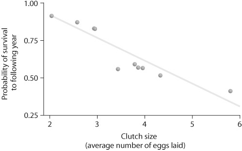 101) Looking at the data in the figure above, what can be said about survival and clutch size? A. Large clutch size correlates with low survival B.Animals with high survival tend to have larger clutch sizes C. Animals with low survival tend to have smaller clutch sizes D. Probability of survivorship does not correlate with clutch size | back 1 A |
front 2 102) What is the primary limiting factor that determines why no femal animal can produce a very large number of very large eggs? A. Temperature constraints will prevent females from carrying too many eggs B. Time is limited C. There will be an increase in predation pressure if the females carry too many large eggs D. There are energy constraints | back 2 D |
front 3 103) You observe two female fish of the same species breeding, One female lays 100 eggs and the other females lays 1000 eggs. Which one of the following is LEAST likely given the limits of fitness trade-offs? A. The eggs from the female laying 1000 eggs have larger yolks than the yolks of the eggs from the female laying 100 eggs. B. The female laying 100 eggs breeds more often than the female laying 1000 eggs. C. The female laying 100 eggs lives longer than the female laying 1000 eggs . D. The female laying 1000 eggs is larger than the female laying 100 eggs. | back 3 A |
front 4 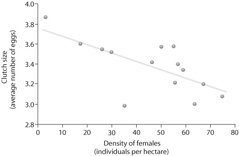 104) Based on the figure above, which of the following statements correctly interprets the data? A. As female density increases, survivorship decreases. B. Clutch size decreases as female density increases C. As female density increases, clutch size increases | back 4 B |
front 5 105) Which pair of terms most accurately describes life history traits for a stable population of wolves? A. iteroparous; r-selected B. semelparous; K-selected C. semelparous; r-selected D. iteroparous; K-selected | back 5 D |
front 6 106) Natural selection involves energetic trade-offs between ___. A. choosing how many offspring to produce over the course of a lifetime and how long to live B. high survival rates of offspring and the cost of parental care C. increasing the number of individuals produced during each reproductive episode and a corresponding decrease in parental care D. producing large number of gametes when employing internal fertilization versus fewer numbers of gametes when employing external fertilization | back 6 B |
front 7 107) Which of the following is characteristic of K-selected populations? A. small offspring B. offspring with good chances of survival C. a high intrinsic rate of increase D. many offspring per reproductive episode | back 7 B |
front 8 108) In which of the following situations would you expect to find the largest number of K-selected individuals? A. a recently abandoned agricultural field in Ohio B. South Florida after a hurricane C. an old-growth forest D. a shifting sand dune community of south Lake Michigan | back 8 C |
front 9 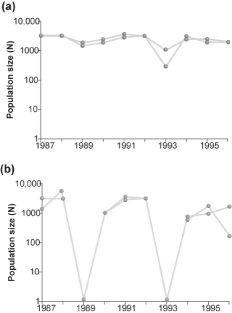 109) Graph (b) in the figure above shows the normal fluctuations of a population of grouse. Assuming graph (a) in the figure above is the result of some experimental treatment in the grouse population, what can be concluded? A. The experimental treatment has most likely identified the cause of population cycling B. The experimental treatment did not affect population cycling in this species C. The experimental treatment exacerbated the population cycling D. None of the other responses is true | back 9 A |
front 10 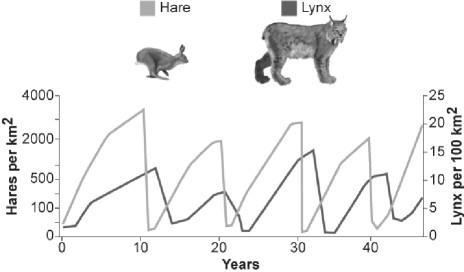 110) What conclusion can you draw from the figure above? A. Lynx control hare population size B. Hares control lynx population size C. Lynx and hare populations are independent of each other D. The relationship between the populations cannot be determined only from this graph | back 10 D |
front 11 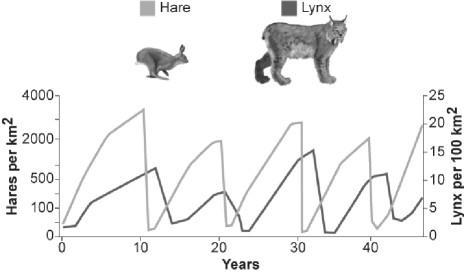 111) Looking at the data in the figure above from the hare/lynx experiment, what conclusion can you draw? I. Food is a factor in controlling hare population size II. Excluding lynx is a factor in controlling hare population size III. The effect of excluding predators and adding food in the same experiment is greater than the sum of excluding lynx alone plus adding fooding alone A. only I B. only II C. only III D. I, II, and III | back 11 D |
front 12  112) Often the growth cycle of one population has an effect on the cycle of another. As moose populations increase, for example, wolf populations also increase. Thus, if we are considering the logistic equation for the wolf population, dN/dt = rN, which of the factors accounts for the effect of the moose population? A. K B. N C. r D. rN | back 12 A |
front 13  113) Which of the following graphs illustrates the growth over several seasons of a population of snowshoe hares that were introduced to an appropriate habitat also inhabited by predators in northern Canada? | back 13 C |
front 14 114) The figure above represents the dynamics of ____ A. extinctions B. emigration C. metapopulations D. both extinction and emigration | back 14 C |
front 15 115) One measure for the value of the patch was given by the long term contribution of a fragment to colonization events in the network. How do the properties of a landscape and the properties of a species affect the value of a patch? The value of the fragment depends ____. A. on neither the properties of the landscape nor the properties of the species B. only on the properties of the landscape and not the properties of the species C. not on the properties of the landscape but only on the properties of the species D. on the properties of the landscape and the properties of the species | back 15 D |
front 16 116) A population of white-footed mice becomes severely overpopulated in a habitat that has been disturbed by human activity. Sometimes intrinsic factors cause the population to increase in mortality and lower reproduction rates to occur in reaction to the stress of overpopulation. Which of the following is an example of intrinsic population control? A. Clumped dispersion of the population leads to increased spread of disease and parasites, resulting in a population crash B. Owl populations frequent the area more often because of increased hunting success C. Females undergo hormonal changes that delay sexual maturation, and many individuals suffer depressed immune systems and die due to the stress of overpopulation D. All of the resources (food and shelter) are used ip by overpopulation, and much of the population dies of exposure and/or starvation | back 16 C |
front 17 117) Based on the diagrams in the figure above and on the large population of baby boomers in the United States, which graph best reflects U.S. population in twenty years? A. A B. B C. C D. D | back 17 B |
front 18 118) Which of the following statements regarding the future of populations in developing countries are correct? I. The fecundity is predicted to increase II. Survivorship will increase III. Overall population size will increase dramatically IV. The number of offspring each year is predicted to remain high. A. only I and III B. only II, III and IV C. only II and IV D. only I, II, and III | back 18 B |
front 19 119) Why does the 2009 U.S. population continue to grow even though the United States has essentially established a zero population growth (ZPG)? A. immigration B. emigration C. baby boomer reproduction D. the 2007-2009 economic recession | back 19 A |
front 20 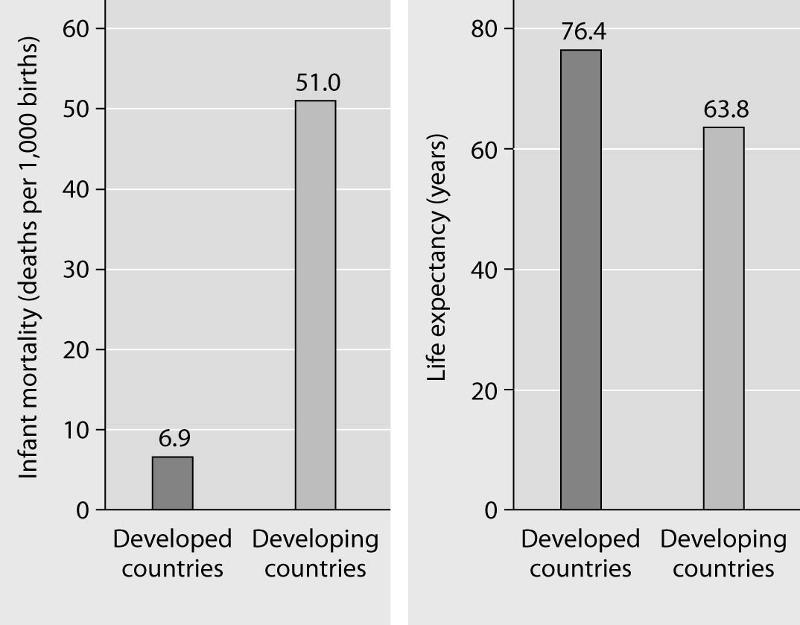 120) What is a logical conclusion that can be drawn from the graphs
above? Developed countries have_____ | back 20 C |
front 21 121) A recent study of ecological footprints concluded that _____ A. Earth's carrying capacity would increase if per capita meat consumption increased B. the ecological footprint of the United States is large because per capita resource use is high C. current demand by industrialized countries for resources is much smaller than the ecological footprint of those countries D. It is not possible for technological improvements to increase Earth's carrying capacity for humans | back 21 B |
front 22 122) Which of the following statements about human population in industrialized countries are correct? I. Life history is r-selected II. The population has undergone the demographic transition III. The survivorship curve is Type III IV. Age distribution is relatively uniform A. only II, III, and IV B. only II and IV C. only I, II, and IV D. only I and III | back 22 B |
front 23  123) Which population(s) appear(s) to be stable? A. I B. III C. I and II D. II and III | back 23 B |
front 24 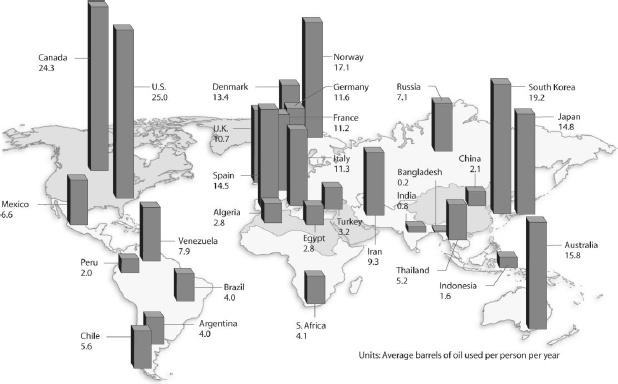 124) Based on the figure above and given the populations of the following countries which country uses the most oil overall? A. China (population = 1.33 billion) B. Russia (population = 144 million) C. Canada (population = 36 million) D. United States (population = 320 million) | back 24 D |
front 25 125) A population of squirrels on an island has a carrying capacity of 350 individuals. If the maximum rate of increase is1.0 per individual per year and the population size is 275, determine the population growth rate ( Round to the nearest whole number) A. 15 squirrels per year B. 59 squirrels per year C. 75 squirrels per year D. 34 squirrels per year | back 25 B |
front 26 126) What would happen to the seasons if the Earth were tilted 35 degrees off its orbital plane instead of the usual 23.5 degrees? A. Winters and summers would be less severe B. Winters and summers would be more severe C. The seasons would be shorter D. The seasons would disappear | back 26 B |
front 27 127) Which of the following might be an investigation of microclimate? A. The effect of sunlight intensity on species composition in a decaying rat carcass B. the effect of ambient temperature on the onset of caribou migration C. the seasonal population fluctuation of nurse sharks in coral reef communities D. competitive interactions between various species of songbirds during spring migration | back 27 A |
front 28 128) Which of the following choices includes all of the others in creating global terrestrial climates? A. Earth's rotation on its axis B. ocean currents C. differential heating of Earth's surface D. global wind patterns | back 28 C |
front 29 129) Why is the climate drier on the leeward (downward) side of mountain ranges that are subjected to prevailing winds? A. Air masses pushed by the prevailing winds are stopped by mountain ranges and the moisture is used up in the stagnant air masses on the leeward side B. Pushed by the prevailing winds on the windward side, air is forced to rise, cool, condense, and drop its precipitation, leaving drier air to descend the leeward side C. Deserts create dry conditions on the leeward side of mountain ranges D. The sun illuminates the leeward side of mountain ranges at a more direct angle, converting to heat energy, which evaporates most of the water present | back 29 B |
front 30 130) What would be the effect on climate in the temperate latitudes if Earth were to slow its rate of rotation from a 24 hour period of rotation to a 48 hour period of rotation? A. winter seasons in both the northern and southern hemispheres would have more abundant and frequent precipitation events B. Seasons would be longer and more distinct (colder winters and warmer summers) C. There often would be a larger range between daytime high and nighttime low temperatures D. Large-scale weather events such as tornadoes and hurricanes would no longer be a part of regional climates | back 30 C |
front 31 131) Subtropical plants are commonplace in Land's End, England, whose latitude is the equivalent of Labrador in coastal Canada, where the local flora is subarctic. Which statement best explains why this apparent anomaly exists between North America and Europe? A. warm ocean currents interact with England, whereas cold ocean currents interact with Labrador B. Rainfall fluctuates greatly in England; rainfall is consistently high in Labrador C. Labrador receives sunlight of lower duration and intensity than does Land's End D. Labrador does not get enough rainfall to support the subtropical flora found in Land's End | back 31 A |
front 32 132) In mountainous areas of western North America, north-facing slopes would be expected to ____ A. receive more sunlight than similar southern exposures B. be warmer and drier than comparable southern exposed slopes C. support biological communities similar to those found at higher elevations on similar south-facing slopes D. support biological communities similar to those found at lower elevations on similar south-facing slopes | back 32 C |
front 33 133) Which of the following events might you predict to occur if the tilt of Earth's axis relative to its plane of orbit was increased to degrees? A. Both northern and southern hemispheres would experience summer and winter at the same time B. Both poles would experience massive ice melts C. seasonal variation at the equator might decrease D. summers and winters in the United States would likely become warmer and colder, respectively | back 33 D |
front 34 134) Imagine some cosmic catastrophe jolts Earth so that its axis is perpendicular to the orbital plane between Earth and the sun. The most obvious effect of this change would be ___ A. a decrease in temperature at the equator B. the elimination of seasonal variation C. the elimination of tides D. an increase in the length of a year | back 34 B |
front 35 135) The main reason polar regions are cooler than the equator is that ____ A. sunlight strikes the poles at a lower angle B. the polar atmosphere is thinner and contains fewer greenhouse gases C. the poles are permanently tilted away from the sun D. the poles are farther from the sun | back 35 A |
front 36 136) The success of plants extending their range northward following glacial retreat is best determined by _____ A. their size B. their tolerance to shade C. their seed dispersal rate D. whether there is simultaneous migration of herbivores | back 36 C |
front 37 137) As climate changes because of global warming, plant species' ranges in the northern hemisphere may move northward. The trees that are most likely to avoid extinction in such an environment are those that ____ A. produce well provisioned seeds B. have seeds that become viable only after a forest fire C. disperse many seeds in close proximity to the parent tree D. have seeds that are easily dispersed by wind or animals | back 37 D |
front 38 138) Generalized global air circulation and precipitation patterns are caused by____ A. air masses that are dried and heated over continental areas that rise, cool aloft, and descend over oceanic areas followed by a return flow of moist air from ocean to land, delivering high amounts of precipitation to coastal areas B. polar, cool, moist high-pressure air masses from the poles that move along the surface, releasing precipitation along the way to the equator, where they are heated and dried C. the revolution of Earth around the sun D. rising warm, moist air masses that cool and release precipitation as they rise and then, at high altitude, cool and sink back to the surface as dry air masses after moving north or south of the tropics | back 38 D |
front 39 139) Air masses formed over the Pacific Ocean are moved by prevailing westerlies where they encounter extensive north-south mountain ranges, such as the Sierra Nevada and the Cascades. Which statement best describes the outcome of this encounter between landform and an air mass? A. The cool, dry Pacific air heats up and picks up moisture from evaporation of the snowcapped peaks of the mountain range, releasing this moisture as precipitation when the air cools while descending on the leeward side of the range B. The warm, moist Pacific air rises and cools, releasing precipitation as it moves up the windward side of the range. This cool, now dry air mass heats up as it descends on the leeward side of the range C. These air masses are blocked by the mountain ranges, producing high annual amounts of precipitation on the windward sides of these mountain ranges. D. The cool, moist Pacific air heats up as it rises, releasing its precipitation s it passes the tops of the mountains. This warm, now dry air cools as it descends on the leeward side of the range | back 39 B |
front 40 140) Coral reefs can be found on the southeast coast of the United States but not at similar latitudes on the southwest coast. Differences in which of the following most likely account for this? A. precipitation B. ocean currents C. salinity D. day length | back 40 B |
front 41 141) Which of the following investigations would shed the most light on the future distribution of organisms in temperate regions that are faced with climate change? A. Quantify the impact of man's activities on present-day populations of threatened and endangered species to assess the rate of extirpation and extinction B. Look at the climatic changes that occurred since the last Ice Age and how species redistributed as glaciers melted, then make predictions on future distribution in species based on past trends C. Compare and contrast the flora and fauna of warm/cold/dry/wet climates to shed light on how they evolved to be suited to their present-day environment D. Remove, to the mineral soil, all of the organisms from an experimental plot and monitor the colonization of the area over time in terms of both species diversity and abundance | back 41 B |
front 42 142) Generally speaking, deserts are located in places where air masses are usually_____ A. descending B. rising C. tropical D. humid | back 42 A |
front 43 143) When climbing a mountain, we can observe transitions in biological communities that are analogous to the changes ___ A. in biomes at different latitudes B. across the United States from east to west C. in a community through different seasons D. in an ecosystem as it evolves over time | back 43 A |
front 44 144) If the direction of Earth's rotation reversed, the most predictable effect would be ____ A. the elimination of ocean currents B. a big change in the length of the year C. winds blowing from west to east along the equator D. a loss of seasonal variation at high latitudes | back 44 C |
front 45 145) Based on the data in the figure above, which of the following statements are correct? I. Area 1 would be considered a desert because of its high average temperature II. Area 1 has more average precipitations than Area 2 III. Area 2 would be considered a desert because of its low average precipitation IV. Area 2 has a larger annual temperature variation A. only I and III B. only II and IV C. only II, III, and IV D. only I, II, and IV | back 45 C |
front 46 146) Based on the data in the figure above, which of the following statements are correct? I. Area 1 has more average precipitation than Area 2 II. Area 1 has a higher average temperature than Area 2 III. Both areas have low variation in monthly precipitation IV. Area 2 has lower annual temperature variation compared to Area 1 A. only II, III, and IV B. only II and IV C. only I and III D. only I, II, and III | back 46 D |
front 47 147) Besides sunlight, which would be the next most important climatic factors for terrestrial plants? A. wind and fire B. temperature and moisture C. moisture and wind D. temperature and wind | back 47 B |
front 48 148) Which statement describes how climate might change if Earth was 75 percent land and 25 percent water? A. Earth's daytime temperatures would be higher and nighttime temperatures lower B. Summers would be longer and winters shorter at midlatitude locations C. Terrestrial ecosystems would likely experience more precipitation D. Earth would experience an unprecedented global warming | back 48 A |
front 49 149) If global warming continues at its present rate, which biomes will likely take the place of the coniferous forest (taiga)? A. temperate broadleaf forest and grassland B. tropical forest and savanna C.chaparral and temperate broadleaf forest D. desert and chaparral | back 49 A |
front 50 150) Fire suppression by humans ____ A. is a management goal of conservation biologists to maintain the healthy condition of forest communities B. can change the species composition within biological communities C. will result ultimately in sustainable production of increased amounts of forest products for human use D. is necessary for the protection of threatened and endangered forest species | back 50 B |